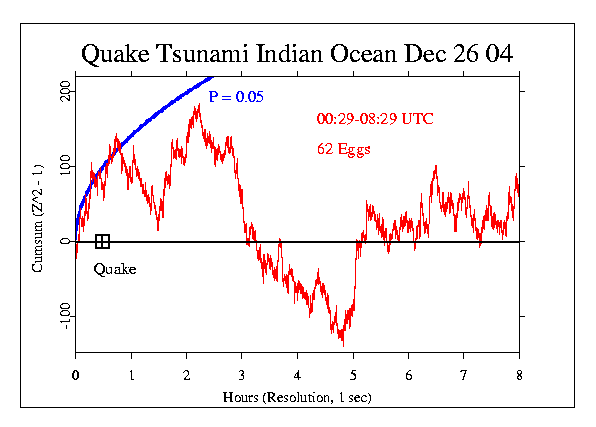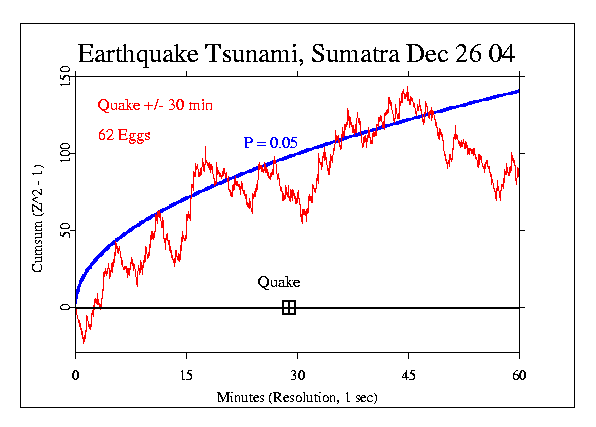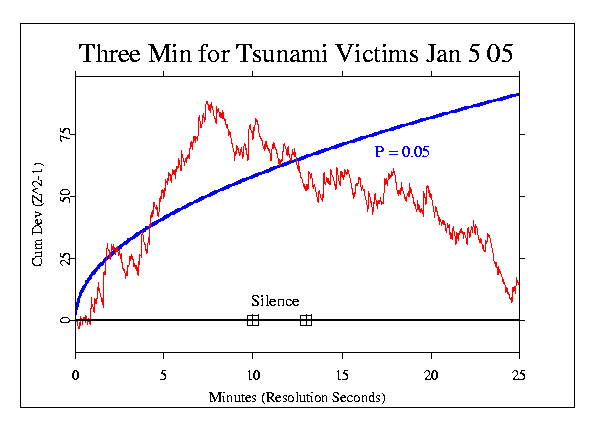|
First reports on Sunday Dec 26 2004 described a massive earthquake and
tidal waves that killed more than 11,000. Each following day the
estimated death toll has doubled, and by late Tuesday, the
numbers are thought to be about 60,000 with great concern that many
more would die from disease.
(AP reports) Tidal waves from a massive undersea earthquake
smashed into coastlines across Asia, washing away whole villages in
Indonesia, Sri Lanka and India and dragging sunbathers out to sea and
snorkelers across jagged reefs at tourist havens in Thailand.
More than 11,300 people were killed in six countries.
The death toll from the most powerful earthquake in four decades climbed
steadily throughout Sunday as authorities counted bodies washed up on
beaches and left hanging like ragdolls from trees.
Foreign tourists were among the dead and the thousands of others who
were reported missing.
Tens of thousands fled the coasts for higher ground, fearing aftershocks
and further flood surges.
Worst hit was Sri Lanka - an island nation some 1,600 kilometers (1,000
miles) west of the epicenter.
The death toll stood at 4,500, according to police and Tamil Tiger
rebels, and 1 million people were displaced.
Sri Lanka's government declared a national disaster.
The 8.9-magnitude earthquake - the strongest since a 9.2 magnitude
temblor in Alaska in 1964 - struck just before 7 a.m. (0100 GMT) off the
west coast of the Indonesian island of Sumatra, about 1,620 kilometers
(1,000 miles) northwest of Jakarta, the capital, the U.S. Geological
Survey said.
It was 10 kilometers (6 miles) deep, and was followed by a half-dozen
powerful aftershocks, ranging in magnitude from almost 6 and 7.3.
Traveling at nearly jetliner speeds, the first huge waves began
pummeling southern Thailand an hour after the quake.
In 2 1/2 hours, the torrents had traveled some 1,600 kilometers (1,000
miles) and slammed India and Sri Lanka.
They eventually struck the East Africa coast in Somalia, killing at
least nine people.
In the Maldives, a string of 1,192 low-lying coral atolls off India's
southwestern coast, President Maumoon Abdul Gayoom declared a state of
emergency after the waves killed an unspecified number of people and
caused extensive damage, the presidential Web site said.
Electricity and communications were cut to parts of the country and few
details were available. In Washington, the White House said that Sri
Lanka and the Maldives were two of the worst-hit countries and that U.S.
relief efforts were under way.
Towns in Sumatra's Aceh province, the closest region to the earthquake's
epicenter, were swamped by the waves.
The health ministry said at least 4,185 people were killed, and hundreds
more were missing in the area.
The quake occurred at a place where several huge geological plates push
against each other with massive force.
The survey said a 1,000-kilometer (620-mile) section along the boundary
of the plates shifted, motion that triggered the sudden displacement of
a huge volume of water.
The reverberations sent waves as high as six meters (20 feet) thundering
into the coasts of six countries, sweeping away tourists, fishermen,
hotels, homes and cars.
This is such a large event that the GCP prediction is for strong
deviations. The formal event designation is for an 8 hour period
beginning half an hour before the main earthquake. This covers the time
for the tidal wave to travel to the coastlines of the Indian ocean, and
some of the time for the developing story to transmit across the world.
In addition, we will do some explorations of the details around the
quake itself and the longer context of time before and after.
The result for the formal segment, shown in the following figure,
is a Chisquare of 28869 on 28800 df and p = 0.3863.
There is a strong early trend, but it does not continue. Instead there
is a wavelike oscillation that is all within chance expectation.
The pattern is very similar to that seen in other quake events, notably
that last year in Bam, Iran.

When we look in detail at the moment of the main temblor of the
Richter 9.0 earthquake, the picture is
of a sharp deviation beginning about 30 minutes before the quake and
continuing with the same steady slope for some time after the shock.
This is similar to the picture around the huge and deadly
earthquake that killed 20,000 people in Turkey a few years ago.

Looking at a larger context is interesting, though
it is difficult to interpret with any certainty. Almost exactly 24 hours
before the Sumatra shock, the GCP data show a huge and unlikely spike.
Then during the first day of the developing tragedy, a wavelike
oscillation dominates the data. Early on Monday, a strong trend begins,
which continues for the next 24 hours. The week following the tsunami
shows mostly a noisy oscillation, but after five days, a steep
gradient begins. Scientific interpretation is inappropriate, but perhaps we
could let this symbolize a return of hope after the days of unimaginable
devastation.

Adrian Patrut suggested looking at the Egg reaction to a moment of
silence for the victims of the Tsunami disaster, 10 days into the
recovery period. Millions of people of all countries that belong to
the European Union plus Switzerland fell silent for 3 minutes on
Wednesday, the 5th of January 2005, between 11.00 - 11.03 UTC. Schools, rail
stations, offices and shops paused in the memory of the victims of
the Indian Ocean area disaster. Buses, trams, subways also
stopped, while TV and radio stations broke into normal programming
to broadcast special commemorations and solemn music.
This figure shows a visually selected period beginning 10 minutes before the
three minutes of silence, with a similar time afterward. Interpret with
care; a different selection would be less visually impressive.

Finally, if we take a different perspective on the data, calculating the
cumulative deviation of the variance across the 62 eggs, there is a
fairly striking shape to the curve, with a sharp drop just before the
powerful tremor, changing to a sharp rise for several hours following
the quake. This can't be interpreted as evidence that the EGG network
was affected by the natural events, but the timing is suggestive.

There was an immediate surge of interest in the GCP following tsunami,
as shown in daily usage statistics.

Many people have asked, given the magnitude of the destruction and the
loss of life, why the EGG network did not show a commensurate reaction.
Several propositions have been made, among them that our compassion was
roused, but only over the course of days as the news penetrated to the
outside world. The direct impact was itself a slowly spreading, albeit
inexorable occurence in many locations and times.
The real answer is that I don't know. But I do speculate, and
the long development of the perception of horrendous disaster
is very different from the sharply focused shock such as defined 9/11.
Another aspect I think is pertinent is the source: Empirically, in the
several years of data for different kinds of events, we have seen
big hits on many human-caused tragedies but on relatively few
natural disasters. Maybe the "global consciousnes" takes the
latter more in stride.
|